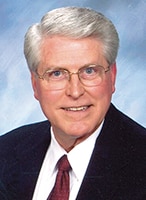 A Visit with Thomas
A Visit with Thomas
Formations: April 23, 2017
Scripture: John 20:19-31
 Michael K OlmstedWe can fantasize about the original apostles who followed Jesus as men of unshakable faith, but the gospel narratives poke gigantic holes in that thinking. Even with the removal of Judas, the remaining eleven appear no different from us. Peter’s epic statement about Jesus, “You are the Christ, the Son of the living God” (Matthew 16:16), is offset by his denial in the courtyard of the high priest after Jesus’ arrest: “I do not know him” (Luke 22:57). James and John exhibited deep loyalty to Jesus, but they evidenced less than spirituality when they sought places of prominence in the kingdom to come (Matthew 10:37)! But when it comes to Thomas, we do this kind of religious sidestep and label him The Doubter!
Michael K OlmstedWe can fantasize about the original apostles who followed Jesus as men of unshakable faith, but the gospel narratives poke gigantic holes in that thinking. Even with the removal of Judas, the remaining eleven appear no different from us. Peter’s epic statement about Jesus, “You are the Christ, the Son of the living God” (Matthew 16:16), is offset by his denial in the courtyard of the high priest after Jesus’ arrest: “I do not know him” (Luke 22:57). James and John exhibited deep loyalty to Jesus, but they evidenced less than spirituality when they sought places of prominence in the kingdom to come (Matthew 10:37)! But when it comes to Thomas, we do this kind of religious sidestep and label him The Doubter!
What about the Thomas who has a deep longing for spiritual truth, the seeker who is not satisfied by simple or clever answers, the apostle who must find a deep personal faith? The Gospel of John presents Thomas in three insightful experiences.
In John 11, Jesus receives the message that his dear friend Lazarus, in Bethany, is sick. A few days pass and Jesus announces he will go to Judea to see Lazarus, but the disciples protest because the Jewish authorities in Judea want to kill Jesus. Thomas is the lone supporter as he tells them all, “Let us go too so that we may die with Jesus” (11:16).
Later, in John 14, Jesus encourages his disciples to see beyond his approaching death to “the place he is going to prepare for them in heaven, a place they should already know about” (14:4). Only Thomas is bold enough to say, “Lord, we don’t really understand … how can we know the way” (14:5)? Thomas, alone, was bold enough to say what the rest were thinking.
Finally, Thomas is the one apostle who missed Jesus’ first resurrection appearance before the other apostles. He has the courage to say to them, “I must see for myself.” We don’t know why Thomas was not present for Jesus first appearance, but his demand to see and touch the crucifixion wounds is too quickly dismissed in our minds as a signal of weak faith.
Faith is easily shaped by our individual emotional/intellectual ideas. Some people believe things because they are comforting or espoused by someone they love or trust. Other people question everything or seek a measured fact-based conclusion. Is reality only found in what you see or touch, taste or hear? Is the world one-dimensional, or is there a tangible and spiritual reality? Can we measure everything and then explain everything? Is reality encapsulated in the relationship of energy and matter, or is there another dimension, free of the physical, yet knowable in this world and in life, that transcends this physical existence?
Although Thomas was not thinking in these modern ideas, he understood that Jesus is real, that God cannot be reduced to a physical presence and that life must be more than a random series of meaningless events. In Jesus, Thomas recognized the ultimate “Word of God” beyond the religious imagination of humanity. Thomas recognized Jesus as God’s promised Messiah, but how could something as horrendous as the cross and final as the grave be God’s way to share his ultimate love with us?
Are we so unlike Thomas? We want answers. We want the 1, 2, 3 sequence of spiritual truth, with irrefutable evidence, concise development and no room for questions. And then this guy Thomas has the audacity to say what we dare not say: I want proof! This is precisely why there is a cross and resurrection. This photo moment captures ten vs. one: ten apostles are delirious with joy because they have seen the risen Christ vs. one apostle who says he has to see the physical evidence for himself.
In that standoff Jesus appears, saying, “Peace be with you” (v. 26). Suddenly the traditional ancient greeting is charged with the energy of God’s grace and presence! Did you notice that Thomas’ response to Jesus’ invitation to touch the wounds seems to be lost in Thomas’ spontaneous response, “My Lord and my God” (v. 28)! This is the first instance in John’s gospel where a person identifies Jesus as being God. In his gospel prologue, John starts with this key idea: “In the beginning was the Word, and the Word was with God, and the Word was God” (John 1:1). I don’t think I’m reading too much into Thomas’ words that his longing to see the risen Christ has enabled Thomas to see God more clearly than ever before. So it should be for us as we read this text.
Don’t overlook Jesus’ response to Thomas. “Do you believe because you see me? Happy are those who don’t see and yet believe” (v. 29). Those words speak to us. You may wish you could see and touch Jesus like Thomas. But the cross is not to be repeated, nor is the resurrection. The act of God’s redemption was a one-time event. As the majestic hymn says, “It is finished, the battle is over!” Romans 6:10-11 reminds us, “For the death that He died, He died to sin, once for all; but the life that He lives, He lives to God. Even so consider yourselves to be dead to sin, but alive to God in Christ” (NASV).
To have seen the risen Christ would be amazing and joyful. John writes that Jesus did many miraculous things that are not recorded, but what he has written should help us believe that Jesus is God’s promised Savior, the One through whom we find true life (vv. 30-31). The four gospels help us see Jesus as the Son of God through three years of ministry and powerful teaching. Repeatedly, not just by spectacular deeds, we witness Jesus’ compassion, his recognition that even social outcasts and enemies are included in God’s love, that power and wealth are insignificant in God’s kingdom and that faith is found in its fullness in the God who cannot be confined to our cultural ideas.
Jesus began his ministry, after John’s baptism, in the wilderness where the devil offered him power, fame and the nations of the world. Jesus rejected those temptations and began his journey to the cross. The resurrection is Jesus’ final choice in the battle against evil and death. Thomas is no more a doubter than any of us as we face the challenges and unknowns of this real world. Our hope and strength comes, not from seeing or touching the wounds of our Savior … our hope comes from his resurrection and his promise to be with us in everything. Hallelujah!
Retired after 46 years in pastoral ministry, Michael K. Olmsted enjoys family, supply preaching and interim work, literature, history, the arts and antiques.
Formations is a curriculum series from Smyth & Helwys Publishing, Inc. through NextSunday Resources.
The PDF download requires the free Acrobat Reader program. It can be downloaded and installed at https://get.adobe.com/reader.


